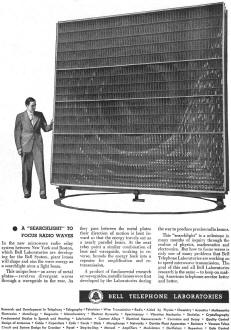|
May 1946 Radio-Craft
 [Table of Contents] [Table of Contents]
Wax nostalgic about and learn from the history of early electronics.
See articles from Radio-Craft,
published 1929 - 1953. All copyrights are hereby acknowledged.
|
At first look this antenna from Bell
Telephone Laboratories appears to be a phased array, but in fact it is a "lens"
that uses reflecting metal fins to direct incoming and outgoing radio waves into
a narrow beam. This is a new approach to the standard method of using a curved (usually
parabolic) reflective dish with a feedhorn. No detail is given about how, if at
all, the phases of the received signals are phase-adjusted at the point they converge
on the back-side waveguide feed. It is sort of akin to the
Osgood optical lens used in lighthouses. Shortly after the end of World War II, Bell
Telephone Labs began a major effort to interconnect the entire country with microwave
relay stations to enhance efficiency and reliability of long distance telephone
calls. Maybe it didn't matter. Bell Labs published many different infomercials in
RF / microwave trade magazines like
Radio-Craft from
the 1940s through the 1960s.
Bell
Telephone Laboratories - A "Searchlight" to Focus Radio Waves
 In the new microwave radio relay system
between New York and Boston, which Bell Laboratories are developing for the Bell
System, giant lenses will shape and aim the wave energy as a searchlight aims a
light beam. In the new microwave radio relay system
between New York and Boston, which Bell Laboratories are developing for the Bell
System, giant lenses will shape and aim the wave energy as a searchlight aims a
light beam.
This unique lens - an array of metal plates - receives divergent waves through
a waveguide in the rear. As they pass between the metal plates their direction of
motion is bent inward so that the energy travels out as a nearly parallel beam.
At the next relay point a similar combination of lens and waveguide, working in
reverse, funnels the energy back into a repeater for amplification and re-transmission.
A product of fundamental research on waveguides, metallic lenses were first developed
by the Laboratories during the war to produce precise radio beams.
This "searchlight" is a milestone in many months of inquiry through the realms
of physics, mathematics and electronics. But how to focus waves is only one of many
problems that Bell Telephone Laboratories are working on to speed microwave transmission.
The goal of this and all Bell Laboratories research is the same - to keep on making
American telephone service better and better.
Bell Telephone Laboratories
Research and Development in Telephony • Telegraphy• Television•
Wire Transmission • Radio • Aided by Physics • Chemistry • Acoustics •
Mathematics Electronics • Metallurgy • Magnetics • Microchemistry •
Electron Dynamics • Spectroscopy • Vibration Mechanics • Statistics •
Crystallography Fundamental Studies in Speech and Hearing • Lubrication •
Contact Alloys • Electrical Measurements • Corrosion and Decay •
Quality Control • Design of Antennas • Cable • Capacitors •
Coils • Cords • Dials • Microphones • Networks • Outside
Plant Apparatus • Resistors • Vacuum Tubes Circuit and System Design for
Crossbar • Panel • Step-by-Step • Manual • Amplifiers •
Modulators • Oscillators • Repeaters • Gain Control
Posted May 13, 2021
| Bell Telephone
Laboratories Infomercials |
|
|
|
|









